Live Reference (2026.0)
With the new Live Reference module, seamlessly send Alias 2026 data to VRED 2026 using Live Reference for your visualization workflows. The Live Reference live connection caches data shared between Alias and VRED. Now, updates done in the Alias, such as camera position, object and component-level transformations, material assignments, and more, are displayed in VRED in real time.
Live Referencing starts in Alias with a loaded .wire file. Selecting Enable Live in Alias generates a temporary cache (.alvred) version of the data, making it available to VRED. In VRED, you create the Live Reference, establishing a live connection to the cache. Your data now appears the same in both applications without additional modifications. Now, as Alias modellers work on their content, their changes are seen by the VRED visualization experts.

From the Scene menu, select Live Reference to access this module.
 Toolbar
Toolbar
Find the following tools in the Live Reference toolbar:
 - Opens a file browser for selecting a Live Reference file, then opens the Create Live References dialog to create the live connection. See Create Live References Dialog for more informatiion.
- Opens a file browser for selecting a Live Reference file, then opens the Create Live References dialog to create the live connection. See Create Live References Dialog for more informatiion. - Removes the selected Live References file from the list.
- Removes the selected Live References file from the list. - Establishes a connection with Alias and updates the selected Live Reference. Use this for updating a file where Automatic Update has been turned off.
- Establishes a connection with Alias and updates the selected Live Reference. Use this for updating a file where Automatic Update has been turned off. - Provides a quick way to find and select the currently selected file in the Reference Editor and Scenegraph.
- Provides a quick way to find and select the currently selected file in the Reference Editor and Scenegraph.
 Search and Filters
Search and Filters
Use the Search field to search by name or with a single character. Note that only single search terms are supported. Further configure your search using the filter settings. Quickly see the search rsults with help from the icons in the columns. Click ![]() to access the filters.
to access the filters.
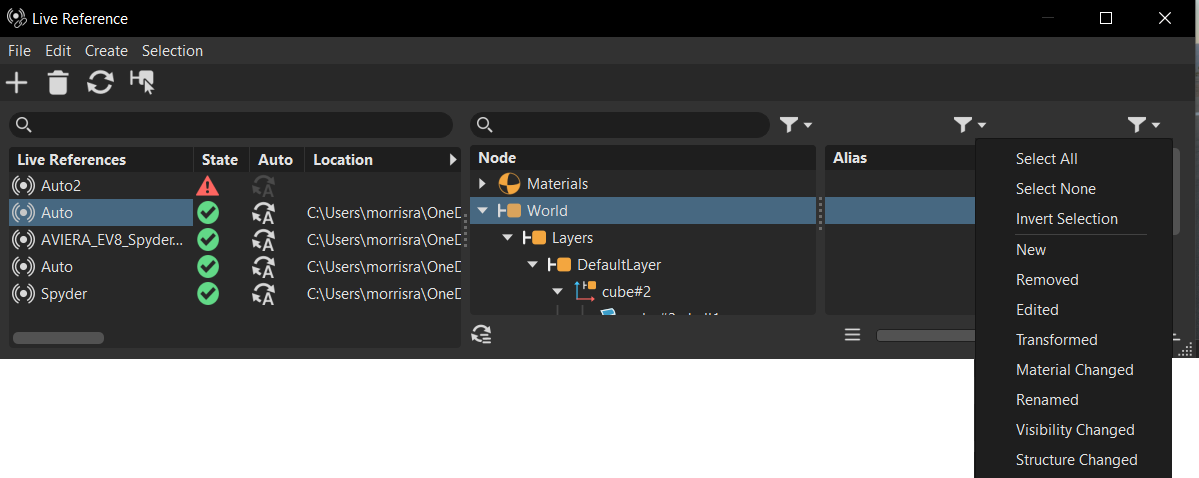
If the node structure is greyed out, click ![]() to reload the node tree.
to reload the node tree.
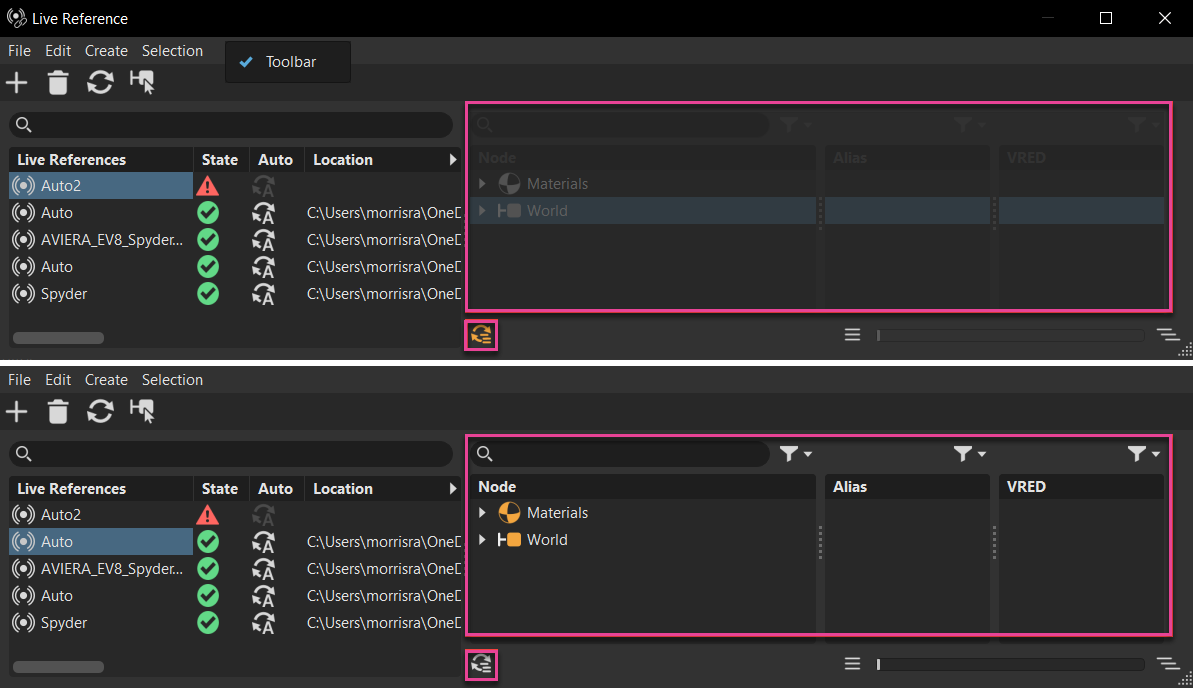
 Live References List
Live References List
Find a list of all Live References and information on their state and that of Automatic Update, as well as the Live Reference and source locations.

To access a list for customizing which columns are displayed, click ![]() . Checked options are displayed and unchecked are hidden.
. Checked options are displayed and unchecked are hidden.

Icons
An assortment of icons are used to help with identifying what things are and their state.
Live Reference - The icon next to a Live Reference indicates its type.
 - Standard Live Reference
- Standard Live Reference - Transformed Live Reference
- Transformed Live Reference - Hidden transformed Live Reference. To unhide it, in either the Scenegraph or Reference Editor, click the box next to it to add a check.
- Hidden transformed Live Reference. To unhide it, in either the Scenegraph or Reference Editor, click the box next to it to add a check.
State - These icons indicate the state of the Live Reference.
 - Good - No issue was found.
- Good - No issue was found. - Warning - An issue was found which needs troubleshooting.
- Warning - An issue was found which needs troubleshooting. - Reload - The Alias Live Reference has changed, and since Automatic Updates is off, the file must be reloaded in VRED to incorporate them.
- Reload - The Alias Live Reference has changed, and since Automatic Updates is off, the file must be reloaded in VRED to incorporate them.
Auto - These icons indicate the status of Automatic Update.
 - Enabled
- Enabled - Disabled - This is due to an issue with the state of the Live Reference file (
- Disabled - This is due to an issue with the state of the Live Reference file ( ).
). - Off - To enable and update the file, click the icon. It changes to
- Off - To enable and update the file, click the icon. It changes to  .
.
Location - Provides the location of the VRED Live Reference file.
Source - Provides the location of the Alias live source file.
Tip:Use the environment variable,
ALIAS_VRED_LIVEREF_LOC, for specifying data location. IfALIAS_VRED_LIVEREF_LOCis used to set the file path, and the Live Reference cache is available, VRED stops looking for other paths and loads the data.
Context Menu
Right-click within the Live Reference area to access a context menu for quickly accessing Update from Alias, Automatic Update, Reload View, Create, Select Nodes, Show in Reference Editor, Re-Import Live Reference, and Replace Live Source. See the Menu section for information on these options.
 Node Column
Node Column
The Nodes column displays the node structure for the currently selected Live Reference. Use the search and filters to quickly locate specific nodes. Use slider, ![]() , and
, and ![]() to expand and collapse the tree.
to expand and collapse the tree.
Node Tree
Nodes in the tree will be either gold, indicating the geometry is visible, grey, indicating the view needs to be reloaded, or white, indicating hidden content. When something is hidden, to make it visible, right-click the Live Reference and select Show in Reference Editor from its context menu. Now, in the Reference Editor, click the box next to the reference to add a check, making its geometry visible. When you return to the Live References module, click ![]() to reload the view.
to reload the view.
| Gold | Grey | White |
|---|---|---|
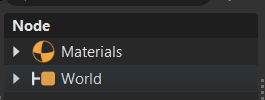 |
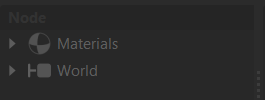 |
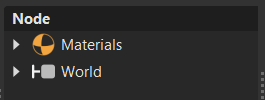 |
Node Filters
Click ![]() and select any of the following options. If the Live Reference contains a node matching the enabled filter(s), the Node column updates. Click
and select any of the following options. If the Live Reference contains a node matching the enabled filter(s), the Node column updates. Click ![]() to expand the tree to see the filtered nodes.
to expand the tree to see the filtered nodes.
If the node structure is greyed out, click ![]() to reload the node tree.
to reload the node tree.

Select All - Selects all the filters, displaying the filtered results.
Select None - Deselect all filters, displaying all nodes.
Invert Selection - Selects all unselected filters, while deselecting the previously selected ones, changing the filtered results.
Materials - Displays only material nodes.

Cameras - Displays camera nodes.
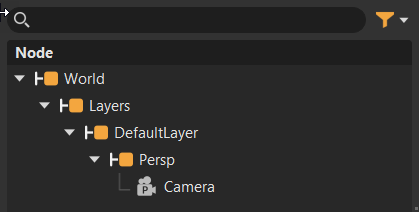
Lights - Displays light nodes.

Annotations - Displays annotation nodes.
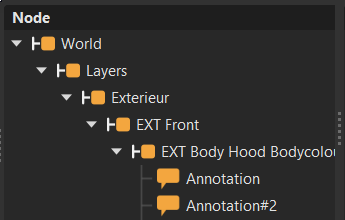
Animations - Displays animated nodes.
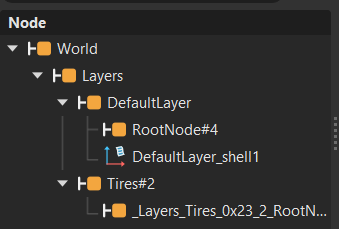
Show Components - Displays components.
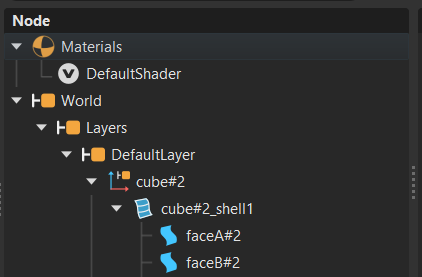
Revert Context Menu
When ![]() is clicked, the context menu options change. Use these options to revert a Live Reference back to its previous state. Find the following options:
is clicked, the context menu options change. Use these options to revert a Live Reference back to its previous state. Find the following options:
- Reload View - Loads the node tree of the selected Live Reference into the Node column, making it selectable and searchable. Use this when working on multiple Live References to switch between them and reload their nodes.
- Select - Selects the node in the Scenegraph and viewport.
- Revert All - Reverts all changes to the Live Reference file back to their previous state.
- Revert Edit - Reverts only edits made to the Live Reference back to their previous state.
- Revert Name - Reverts any name changes to the Live Reference back to their previous state.
- Revert Material - Reverts any material changes to the Live Reference back to the previous state.
- Revert Transformation - Reverts any transformation changes to the Live Reference back to the previous state.
- Revert Visibility - Reverts any visibility changes to the Live Reference back to the previous state.
- Revert Structure - Reverts any changes to the node structure of the Live Reference back to the previous state.
 Alias and VRED Columns
Alias and VRED Columns
When filters are set, icons may appear in the columns, indicating a match. This makes it easier to identify matching nodes. Click the icon in the column to highlight the node in the node tree.
![]()
Alias and VRED Filters
Click ![]() and select any of the following options. If the Live Reference contains a node matching the enabled filter(s), the column updates. To see which node(s) match the filter (indicated by an icon in the Alias or VRED column), click
and select any of the following options. If the Live Reference contains a node matching the enabled filter(s), the column updates. To see which node(s) match the filter (indicated by an icon in the Alias or VRED column), click ![]() . If no nodes are displayed, there is no match.
. If no nodes are displayed, there is no match.

- Select All - Selects all the filters, displays icons for the filtered results, and updates the nodes displayed in the Node column accordingly.
- Select None - Deselect all filters.
- Invert Selection - Selects all unselected filters, while deselecting the previously selected ones, changing the filtered results.
- New - Displays
 in the Alias or VRED columns, indicating nodes added to the file. The nodes in the Node column also update.
in the Alias or VRED columns, indicating nodes added to the file. The nodes in the Node column also update. - Removed - Displays
 in the Alias or VRED columns, indicating nodes removed from the file. The nodes in the Node column also update.
in the Alias or VRED columns, indicating nodes removed from the file. The nodes in the Node column also update. - Edited - Displays
 in the Alias or VRED columns, indicating edited nodes. The nodes in the Node column also update.
in the Alias or VRED columns, indicating edited nodes. The nodes in the Node column also update. - Transformed - Displays
 in the Alias or VRED columns, indicating transformed nodes.
in the Alias or VRED columns, indicating transformed nodes. - Material Changed - Displays
 in the Alias or VRED columns, indicating nodes with material changes.
in the Alias or VRED columns, indicating nodes with material changes. - Renamed - Displays
 in the Alias or VRED columns, indicating renamed nodes.
in the Alias or VRED columns, indicating renamed nodes. - Visibility Changed - Displays
 in the Alias or VRED columns, indicating nodes with changed visibility.
in the Alias or VRED columns, indicating nodes with changed visibility. - Structure Changed - Displays
 in the Alias or VRED columns, indicating a change to the node structure of the Live Reference.
in the Alias or VRED columns, indicating a change to the node structure of the Live Reference.
Revert Context Menu
When ![]() is clicked, the context menu options in the Alias and VRED columns change. Use these options to revert a Live Reference back to its previous state. Find Reload View, Select, Revert All, Revert Edit, Revert Name, Revert Material, Revert Transformation, Revert Visibility, and Revert Structure. For information on these options, see Revert Context Menu in the Node Column section.
is clicked, the context menu options in the Alias and VRED columns change. Use these options to revert a Live Reference back to its previous state. Find Reload View, Select, Revert All, Revert Edit, Revert Name, Revert Material, Revert Transformation, Revert Visibility, and Revert Structure. For information on these options, see Revert Context Menu in the Node Column section.
References from Alias
The Alias user determines when a live connection is established with VRED and how their changes to the content are handled. If the Alias user selects Enable Live, the content is live and changes are seen by the VRED user as they happen. If, however, the Alias user selects Enable on Save, once the file is saved, the Alias changes are part of the Live Reference, and Sync must be selected to send these updates to VRED
On the VRED side, if Automatic Update is enabled, whenever changes are live for VRED, the VRED user sees them. However, the VRED user can choose when to consume the Alias scene changes. With Automatic Update disabled, the VRED user selects Update from Alias to synchronize with Alias when they want.
Why we provided these options is because people like to work in different ways. A modelling lead might want to build up a VRED scene for a review and have whatever they see in Alias to be the same as what exists in VRED. But, only updates they deem appropriate get updated in the Live Reference file.
In another situation, a modelling lead might want the latest changes to "live update" to VRED, without additional intervention. If the source of a Live Reference updates, for example, a seat model changes, this automatically updates in VRED through a Live Reference, once a decision is made via the Reference Manager in Alias. In this case, an Alias and VRED scene could look different, with the Live Reference workflow not being a 1 Alias to 1 VRED scene. However, this case allows for robust master file building to happen using VRED, with a more flexible collaborative workflow and varying steps for updating data across the workflow.
Troubleshooting in VRED
Most of the time, when an issue arises with a Live Reference, a warning ![]() is displayed. Use the Live Reference module and Reference Editor to identify the source of an issue, which may be in Alias or VRED. Let's look at what comes through from Alias to better set our expectations, then at common issues you may encounter and how to resolve them.
is displayed. Use the Live Reference module and Reference Editor to identify the source of an issue, which may be in Alias or VRED. Let's look at what comes through from Alias to better set our expectations, then at common issues you may encounter and how to resolve them.
How Alias Content is Handled
Since not everything from Alias comes over in a Live Reference, this section provides information on what does and does not come through, as well as what is created, if things aren't brought over as expected.
Animation and Annotations from Alias
Find support for the following when using Live Reference:
When an Alias user makes changes to transform or geometry animations, VRED shows these changes, as long as Automatic Update is enabled.
When an Alias user makes changes to an annotation, VRED displays these changes, as long as Automatic Update is enabled.
Limitation: At present, annotations created in VRED are not exportable to Alias.
Camera from Alias
At present, when VRED pulls cameras from a Live Reference, camera position in x/y/z space and its current orientation angle are synchronized with Alias, and only basic settings, such as focus distance, clipping range, and field of view, are available. Camera matching from Alias is also supported in the VRED Live Reference file.
Limitation: Camera settings such as F-Stop, Autofocus, Depth of Field, and camera scaling are not synced between Alias and VRED and orthographic cameras from Alias are currently ignored.
Environment from Alias
Limitation: At present, VRED does not create or update environments through a Live Reference. If the VRED user wants an environment, they will have to create it in VRED.
Lights from Alias
When VRED pulls lights from a Live Reference, the following light types are synchronized between Alias and VRED:
- Area Light
- Directional Light
- Spot Light
- Point Light
Limitation: Linear and Ambient Lights from Alias are not supported in VRED.
The following properties are synchronized and there is a slight change to Cast Shadows (Alias), which is mapped to Cast Shadows on Shadow Material (VRED):
- Position
- Direction
- Color
- Intensity
Some additional parameters are synchronized for specific light types and the values are adjusted to match the VRED light.
For Area Light, Area Size is synced.
For Spot Light, Spread (Alias) is mapped to Cone Angle (VRED) and Penumbra (Alias) is mapped to Penumbra Angle (VRED)
World Space Texture Projections from Alias
You can now freeze the World Space Texture Transform at the object level, if satisfied with the texture scaling, yet want to move or animate the model in space. Find these options in the Scenegraph Edit and context menus.
Since this introduces an additional level of complexity and can result in different behaviors for objects that share the same material, try using the Scenegraph Selection Filter Menu ![]() > Frozen Texture Transform to select all nodes in the tree and viewport with frozen texture transformations.
> Frozen Texture Transform to select all nodes in the tree and viewport with frozen texture transformations.
Freeze World Space Texture Transform - Freezes the current world space transform of the geometry for calculating triplanar, planar, or procedural texture projections. Freezing the world space texture transform stores the current world space transform with the geometry and uses it for texture projection calculations. When the transform is frozen, any transformations on the geometry no longer affect the texture projections, keeping the resulting texture sticking to the geometry.
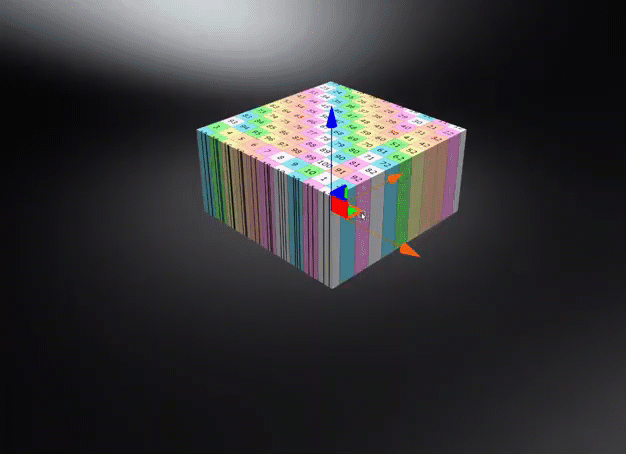
An object with a world space texture projection with it frozen Clear World Space Texture Transform - Removes a previously frozen world space texture transform from the geometry.
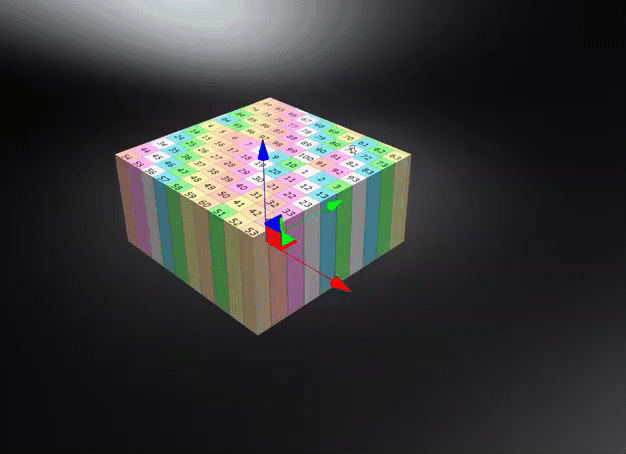
An object with a world space texture projection unfrozen
Filtering for Frozen Texture Transforms
When working in the Scenegraph, to quickly find any frozen texture transforms, use the Frozen Texture Transform option in the Selection Filter Menu.
| Scenegraph Before | Scenegraph Filtered |
|---|---|
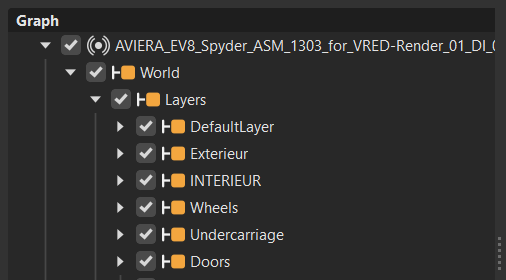 |
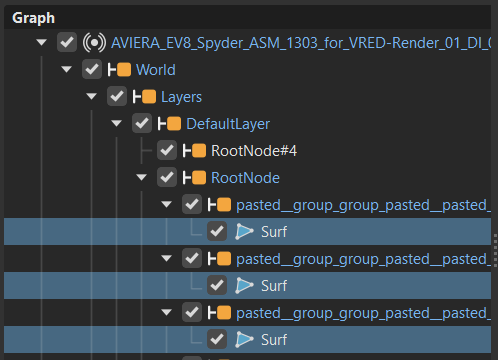 |
Setting the Projection Space
We also added the Projection Space option, which sets the texture coordinate system to be used for texture projections, to the Realistic tab > Common section of the Material Editor.
VRED takes into account a model's scaling and translation during texture projection, as well as when determining the size of flakes in the Carpaint material. This consideration can be beneficial, as it prevents textures with Triplanar Mapping from remaining static in space. However, it can also be problematic. For instance, if models are created in different units and have scaling applied to the root node after import, the flakes in the Carpaint material will be the wrong size. Previously, the only solutions were to flush all scalings in the Scenegraph or adjusting the Flake Size in the material, making it difficult to reuse it across multiple objects with different scalings.
Choose from:
Object Space - Calculates triplanar, planar, or procedural texture projections in object space, ensuring textures transform with the object and maintain their relative placement regardless of the object's position in the scene. Use this to rotate an object and have the texture rotate with it.
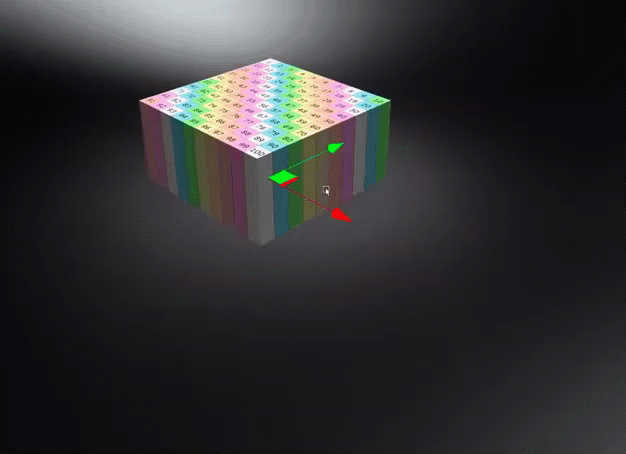
World Space - Uses the world space for calculating triplanar, planar, or procedural texture projections, where the projected textures or structures remain independent of object transformations unless the world space texture transform is frozen. Use this for a ground texture where the texture needs to be aligned to the world space. Be aware, this could cause a distortion on the surface, depending on its rotation.

Common Issues
Here are some common issues you may encounter and how to resolve them.
Issue: You are trying to load a Live Reference, but there is not one for the selected
.wirefile. A warning appears in the Live Reference module.
appears in the Live Reference module.Solution: Contact the owner of the Alias
.wirefile and ask them to create a Live Reference to resolve the issue.
Issue: A Live Reference that once displayed
 , indicating the file was fine, now displays a warning
, indicating the file was fine, now displays a warning  . The link to the Live Reference has been lost and must be re-established.
. The link to the Live Reference has been lost and must be re-established.Solution: Right-click and select Replace Live Source, then select a replacement file, and click Open. The link is re-established and the Live Reference state now displays
 , indicating the issue has been resolved.
, indicating the issue has been resolved.Issue: A purple checked material appears on some parts of the model in VRED. In Alias, it looks different. This indicates a missing texture that cannot be found by VRED.
Alias VRED 
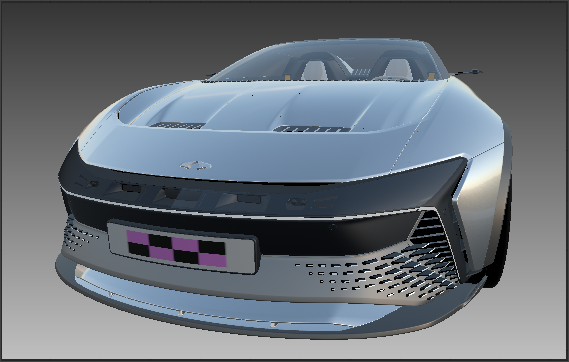
Solution: In the Material Editor, select the material and click
 next to Use Texture.
next to Use Texture.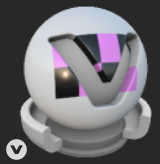
Ask the Alias user for the texture location and add it here or select a replacement to fix the issue.
Issue: The nodes in the node tree are greyed out.
Solution: Use Reload View. See Node Column for more information.
Issue: While trying to create a Live Reference, in the Create Live Reference dialog, the status reads, Failed to load Live Data. In Alias, the file has not been enabled live.
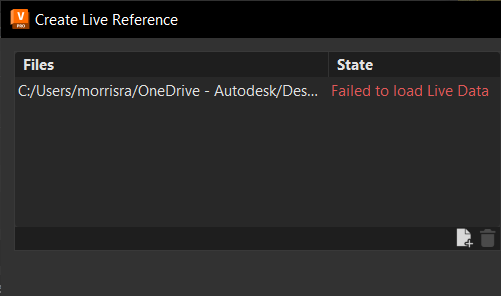
Solution: Contact the Alias user and ask them to select Enable Live to establish a connection. Now, in the VRED Create Live Reference dialog, click OK. The issue is resolved, now that a connection has been established. The dialog closes and the file will now appear in the Live References list.
Issue: For this issue, there are two scenarios where the reason for it and solution are the same.
In the Create Live Reference dialog, the status reads, Failed to load Live Data.
OR
You are not seeing Alias changes, though the file is live and you have either enabled Automatic Updates or have used Updates from Alias.
On the Alias side, the initial Live Reference path is saved internally. VRED uses this for the live connection. However, the Alias user can introduce an issue when trying to find the Live Reference data in VRED. This can happen if they move the .wire file to another location or if the Alias user changes to use a Live Reference path location set in their preferences. In such cases, the internal location no longer matches the used location. Changes are now saved in the new location, but VRED is looking in the initial internal location.
Solution:* If the Alias user performs a Save As, it saves the new Live Reference location internally. In this case, the VRED user needs to replace the original Live Reference with the new wire file. Alternately, you can set the same live Reference path location in both Alias and VRED. Go to Edit > Preferences > Scene > References > References tab > Live Reference Data, click
 next to Storage Location and paste it here. Now, both Alias and VRED are pointing to the same location and the live connection is re-established.
next to Storage Location and paste it here. Now, both Alias and VRED are pointing to the same location and the live connection is re-established.
Issue: Cannot find the storage location for the Live Reference.
Solution: By default, Live Reference files can be found next to the
.wirefile, wherever it is stored. Use the Storage Location preference in the Live Reference Data section of the Scene > References > References tab, to change the default storage location for the Live Reference files in VRED.
Troubleshooting with the Reference Editor

We added a Live section to the Reference Editor that shows the status of a Live Reference file. See its state, whether it is up-to-date or there's an issue, if automatic update is activated, as well as if the file is open in the Live Reference Editor and its location.
The Live section contains columns displaying icons to indicate the Live References file status, automatic update state, whether a file is open, and file location. Use the Source section for the source file status, state, owner, and location. Also, the new context menus options are the same as those found in the Reference Editor's menus, see the Reference Editor Menu Bar for information on these.
Status
The color of an icon indicates the state of a Live References file.
 Green indicates the content is synchronized between Alias and VRED.
Green indicates the content is synchronized between Alias and VRED. Orange indicates Auto is disabled and changes exist. Clicking this icon triggers an update, syncing the products. The icon then changes to green.
Orange indicates Auto is disabled and changes exist. Clicking this icon triggers an update, syncing the products. The icon then changes to green. Red indicates an warning error.
Red indicates an warning error.
Auto
The color of an icon indicates the state of automatic updating.
 Orange indicates auto updating is enabled. Clicking the icon disables automatic updates, changing the icon to light grey.
Orange indicates auto updating is enabled. Clicking the icon disables automatic updates, changing the icon to light grey. Grey indicates auto updating is disabled. Clicking the icon enables automatic updates, changing the icon to orange.
Grey indicates auto updating is disabled. Clicking the icon enables automatic updates, changing the icon to orange.
Open
The color of an icon indicates whether the Live Reference module is opened or closed.
 Grey indicates the Live Reference module is closed.
Grey indicates the Live Reference module is closed. Orange indicates the Live Reference module is open.
Orange indicates the Live Reference module is open.
Location
Find the path to the folder where Alias writes the Live References data. This can be used to see when both products are out-of-sync. When the file is out-of-sync, the Alias and VRED users would see different folders.
Creating a Live Reference
Select Scene > Live Reference to open the Live Reference module. When you click ![]() , locate and select a file, then click Open, the Create Live Reference dialog appears. Choose whether or not to apply materials from the Asset Manager before the Live Reference is created. This can save you time. Once OK is clicked, if no issues arise, a live connection is established between Alias and VRED, and the file is added to the Live References list.
, locate and select a file, then click Open, the Create Live Reference dialog appears. Choose whether or not to apply materials from the Asset Manager before the Live Reference is created. This can save you time. Once OK is clicked, if no issues arise, a live connection is established between Alias and VRED, and the file is added to the Live References list.
Create Live Reference Dialog
Use the Create Live Reference dialog to establish the live connection between the Alias and VRED. These are the options found in the Create Live Reference dialog.

 Files - Lists the files that will become Live References and their locations.
Files - Lists the files that will become Live References and their locations. State - Displays the state of the Live Reference file. Before OK is clicked, the status is Pending. Once OK is clicked, if there are no issues, the dialog closes and the Live Reference module appears. However, if there is an issue with establishing the connection, the status reads, Failed to load Live Data.
State - Displays the state of the Live Reference file. Before OK is clicked, the status is Pending. Once OK is clicked, if there are no issues, the dialog closes and the Live Reference module appears. However, if there is an issue with establishing the connection, the status reads, Failed to load Live Data.
This happens because the file has not been enabled live in Alias. To fix this, the Alias user must select Enable Live. Once this is done, in the Create Live Reference dialog, the VRED user clicks OK. Now that a connection has been established, the issue is resolved. The dialog closes and the file appears in the Live References list.

 - Adds import files to the list. Click
- Adds import files to the list. Click  . Navigate to the file or files, select them, then click Open to load them into the Files list.
. Navigate to the file or files, select them, then click Open to load them into the Files list. - Removes the selected loaded files from the list. In the Files list, select one or more files, then click
- Removes the selected loaded files from the list. In the Files list, select one or more files, then click  .
.
 Material Options - Provides options for applying materials from the Asset Manager to the Live Reference scene as the connection is made and the file is loaded. Click OK once finished.
Material Options - Provides options for applying materials from the Asset Manager to the Live Reference scene as the connection is made and the file is loaded. Click OK once finished.Apply Materials from Asset Manager - Enables materials from the Asset Manager to be applied to the Live Reference scene. Use with Select Folder.
Select Folder - This option is active once Apply Materials from Asset Manager is enabled. Opens the Asset Manager for selecting and applying materials by name from the Asset Manager to the Live Reference scene.
Preferences for Live References
By default, Live Reference files can be found next to the .wire file, wherever it is stored. Use the Storage Location preference in the Live Reference Data section of the Scene > References > References tab, to change the default storage location for the Live Reference files in VRED.
Live Reference Changes in the Scenegraph
When working in the Scenegraph, to identify Live Reference files, look for these icons:
 indicates a standard Live Reference file.
indicates a standard Live Reference file. indicates a transformed Live Reference file.
indicates a transformed Live Reference file.
We also added the following menu options:
Update from Alias, Automatic Update, and Show in Live Reference Module were added to the References menu.
Freeze World Space Texture Transform and Clear World Space Texture Transform were added to the Edit menu.
 Menu Bar
Menu Bar
